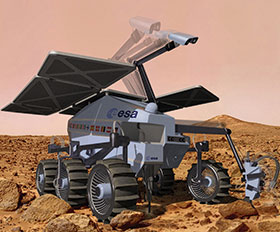

2020 is the year of the next rover mission to Mars. The main payload of the Russian Proton rocket is the ExoMars rover, developed by the European and Russian Space Agencies (ESA and Roskosmos). The plan is for the vehicle to be equipped with nine measuring instruments, including one that will be mounted on a two metre mast on the rover. The panoramic wide angle camera (WAC) will take stereo images of the planet. The PanCam features two rotating filter wheels which are mounted in front of its wide angle cameras to enable it to take three dimensional images of panoramic landscapes. Three stepper motors from Faulhaber drive the rotation shaft for the filter change system as well as the focus of the high resolution camera.
The requirements for equipment planned for use on Mars are so stringent that nothing quite compares to them. And if the mission goes according to plan, the rover built by ESA will start searching the surface of Mars for past or present biological activity as soon as it lands. Meanwhile, the ExoMars Trace Gas Orbiter will stay in orbit in order to help the rover phone home and ensure that the data it collects make it back to earth.
Improved images and protection from dust
The ambient conditions on Mars require every single piece of equipment to deliver unrivalled performance. For starters, the rover will be working under an atmospheric pressure of 0,00636 bar, which is equivalent to the pressure found at an altitude of 35 kilometres on earth. And temperature fluctuations go from 20 down to -120°C.
With the filters in front of the WACs, the system will be able to take pictures at various wavelengths during the mission and use them to generate images with varying content. “The plan is to send 10 images to earth every day,” says Jonathan Jones, mechanical engineer at the Mullard Space Science Laboratory (MSSL) in London.
Stepper motors position lens filters
With 11 filters per wheel, it is possible for the Pancam WACs to take a wide variety of pictures under various light conditions. These filter wheels rotate in front of the two WACs, and must be brought exactly into position in order to obtain sharp images. For driving the rotating filter system, MSSL makes use of two stepper motors from the Faulhaber PRECIstep portfolio. These two units have been passing the endurance tests currently being conducted on them with flying colours.
During the development process, the MSSL engineers looked for motors that would not only be able to deliver reliable and precise positioning performance, but that would also be extremely compact. Stepper motors were the natural choice given these requirements, as they are not only able to precisely position objects with a resolution of 1280 steps per revolution without the need for a separate feedback system, but are also much sturdier and easier to use than conventional servo-motors. The focusing mechanism of the high resolution camera is driven by a Faulhaber PRECIstep stepper motor. “It is the perfect solution for optical application as the motors can hold the lens position even without current thanks to their residual torque. Moreover, the control in open loop gets rid of jittering effects so we obtain very sharp and clear images,” explains Faulhaber PRECIstep, sales manager, Sè’bastien Vaneberg. “In short, it is a simple and robust drive with outstanding capabilities, ideal for the harsh space conditions.”
Miniature motors approved for use on Mars
In each camera, each drive has a diameter of just 10 mm. The stepper motor counts 20 steps per revolution, and is combined with a precision gearhead of the same diameter with a gear ratio of 64:1. On top of this, Faulhaber worked closely with MSSL to further customise the engineering behind its two drives. The resulting changes include a dry lubricant and custom sintered bearings. “The motors need to be able to survive on Mars,” Jones says.
The MSSL is currently testing the components in conditions even harsher than those on Mars. The positioning drives must complete 5000 positioning cycles with temperatures oscillating between -130 and 50°C. “The motors are really showing what they’re made of,” Jones happily reports. During the development of the drives, there was nothing else on the market that could come even close to the Faulhaber units, not to mention the fact that Faulhaber is already a go-to partner for the ESA.”
For more information contact David Horne, Horne Technologies, +27 (0)76 563 2084, [email protected], www.hornet.cc
| Tel: | +27 76 563 2084 |
| Email: | [email protected] |
| www: | www.hornet.cc |
| Articles: | More information and articles about Horne Technologies |

© Technews Publishing (Pty) Ltd | All Rights Reserved